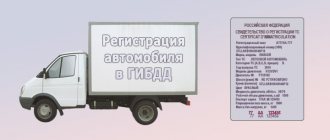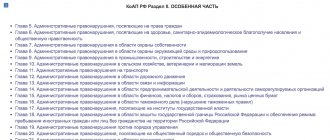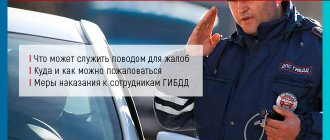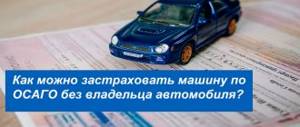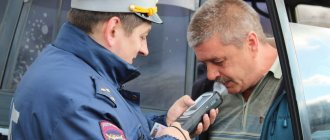AutoYurait.rf / Registration and accounting
Back
Published: March 24, 2019
Reading time: 7 min
10
2320
When purchasing a car, a potential buyer may find that the car is subject to a registration ban. Is this circumstance something dangerous for the buyer? In what cases is this prohibition imposed? And how is the ban lifted? These issues will be discussed below.
- Prohibition on registration actions - what is it? Who can impose a ban?
- Who is lifting the restrictions?
- Arrest, ban and restriction - is there a difference?
- Check through the traffic police website
- How to remove the ban in case of sale?
- Is it possible to drive a car with a trailer that is restricted?
- Is it possible to speed up the lifting of the ban?
Prohibition on registration actions - what is it?
A registration ban is an administrative measure according to which the car owner loses the right to any registration actions regarding the vehicle. The object of the ban can be either a car or a trailer. After the ban is imposed, a person can continue to drive such a car, but he cannot re-register it to another person (the rules are similar for a trailer).
A ban on registration actions is imposed if the driver fails to fulfill his civil obligations (late fine, refusal to pay alimony, etc.), as well as in the event of theft of the car.
Who can impose a ban?
The imposition of a ban is carried out only on the basis of a court decision or a special act - a resolution that is issued and stored in the Bailiff Service (FSSP). The following organizations may act as initiators of the ban:
- The courts themselves. Most often this happens in the case of resolving controversial issues that relate to the division and/or sale of property. For example, during a divorce, the car remained with the ex-husband, but the court ordered the ex-wife to pay certain monetary compensation - in this case, the court may additionally impose a registration ban on such a vehicle.
- Customs. If during registration a person does not pay customs duties, then these authorities can, through the court, impose a ban until the debts are repaid.
- Police. If the car was stolen, then it is quite likely that the thief will want to resell the car - to reduce the likelihood of such a transaction, the police may require the court to impose a ban.
- Traffic police If the traffic police inspector imposes a fine on the driver, and the driver evades paying the fine, the traffic police may go to court to impose a ban.
- Social services. If the ex-husband has a car, but he does not pay child support, then the mother can contact social authorities to prohibit her husband from registering.
More on the topic: Checking the trunk of a car by a traffic police inspector: in what cases is it legal and necessary?
Who is lifting the restrictions?
After a ban is imposed through the court, the case is transferred to the FSSP. To lift the ban, the owner of the car must first fulfill his obligations, which he evades, and then the body that initiated the ban lifts it. For example, the measure in question was imposed due to a traffic fine - in this case, the person must contact the traffic police and make payment. Restrictions can also be lifted through the court (for example, if the ban was imposed by mistake).
Arrest, ban and restriction - is there a difference?
Remember that there is a difference between the seizure of a vehicle, a ban on registration and a restriction on property rights regarding a car. Main differences:
- The registration ban applies only to situations where re-registration of car documents is required. Even if the court has imposed a ban, the owner still has the right to drive the vehicle or use the car as collateral. Theoretically, such a car can be sold, although in practice it is unlikely that anyone will want to buy such a car, since it will not be possible to register it in their name.
- The restriction on the exercise of property rights only affects the possibility of transferring the car to another person. That is, you cannot sell such a car or use it as collateral.
- An arrest implies the removal of a car from use (most often, vehicles are confiscated in favor of the FSSP). If the court issues a seizure order, the person is deprived of all rights to the car, and the seizure can be carried out using compulsory measures.
Consequences of buying a car with a ban
A restriction in the form of a ban on performing registration actions is one of the types of liability measures to which the owner of a car is called upon to comply after a violation of traffic rules (road rules) or improper operation of a potentially dangerous vehicle is detected. When a motorist has already bought a car with a registration ban and does not know what to do with it now, he must first understand the consequences of this transaction.
Features of the right acquisition status:
- The car cannot be the subject of any transactions - sale, exchange, transfer for temporary use or even donation.
- Bailiffs have the right to confiscate the car and put it in a paid impound area. But practice shows that they usually leave it to the owner, indicating restrictions on use.
- You can't drive a car.
- When the violator fails to pay all the fines, does not fulfill all the requirements determined by law and the court decision, and the ban on registration actions comes to an end, the car will be confiscated from him and then transferred to the buyer.
Note! The last note does not apply to the new owner-buyer who has already paid for the car. And in cases where a seized car is sold on the initiative of a bailiff as an executor of a court decision that was not fulfilled by the debtor.
How to check a car for restrictions?
Information about the ban is stored in the traffic police database, and you can check this information using the traffic police website or the FSSP. Below we will look at these verification methods.
Check through the traffic police website
The check is carried out like this:
- Open the traffic police website, select “Services” and “Car check” or follow the direct link https://gibdd.rf/check/auto.
- Enter the vehicle’s VIN code, select “Restrictions” and click the “Request Verification” button. Wait for the operation to complete.
- If there is a ban, then a special window will pop up, where all the basic information about the ban will be indicated (the basis for imposing the ban, the court order, the name of the bailiff, and so on). If there is no prohibition, a window will pop up indicating that the relevant information was not found.
Check through the FSSP
You can also check the information through the Bailiffs website:
- Open the FSSP website, select “Services” and “Bank of Production” or follow the direct link https://fssprus.ru/iss/ip.
- Enter your region of residence, full name and date of birth, and then find the “Find” button. At the end, a window will open in which it will be indicated whether the machine is prohibited or not.
- Using the FSSP website, you can also find out the details of the ban: to do this, through the traffic police website, find the resolution on imposing restrictions and copy the resolution number - then in the search menu on the FSSP website, select “Search by individual entrepreneur”, insert the resolution number and click the “Find” button "
More on the topic: Registration of documents for repainting in the traffic police
Checking the ban on car registration on the traffic police website
To obtain information about a ban on registration of a vehicle, you will need:
- Go to the official website of the State Road Safety Inspectorate.
- In the top menu, select the “Services” category and the “Vehicle check” section.
- The active line will appear in the window that opens. You should enter the VIN number of the body or chassis.
- Request a review.
- The system will follow the link and the user will receive the necessary information about the existing restrictions on this vehicle.
The official website of the State Traffic Safety Inspectorate makes it possible to obtain the necessary information regarding any vehicle in the shortest possible time.
How to remove the ban?
To remove the restrictions, you must fulfill your obligations, evasion of which served as the basis for imposing the restriction. In general, the algorithm is like this:
- Find the ruling. This can be done using the traffic police or FSSP website (we discussed this issue above). You can also submit a request through a personal visit to the MREO.
- Read the resolution to find out what served as the basis for the ban. If you do not agree with it, then collect documents and go to court to protect your rights.
- If you agree with the resolution, then you must fulfill your obligations, which you are avoiding. For example, you still have a traffic fine - in this case, the fine must be paid off.
- After paying all fines, you need to contact the authority that initiated the ban. You need to submit an application to this body with a request to cancel the registration ban (you also need to take your passport and documents for the car with you). As a result, you should be given a decree to lift the ban.
- In some cases, at the end you should also submit a copy of the decision to lift the ban to the FSSP.
Differences between prohibition, arrest and restriction
Experts remind that it is important to distinguish between concepts such as:
- Car registration ban. This means that the vehicle can be used for personal or commercial purposes, but any procedures related to deregistration or registration cannot be performed.
- Arrest. It is a complete ban on the disposal of movable property. The owner cannot operate the vehicle or make any transactions with the vehicle, including leasing it. It is also prohibited to make changes to the design or documents.
- Limitation. Represents the inability to dispose of one's property. For example, a car is pledged to a bank. But using the car for personal purposes is allowed.
Is it possible to sell a car that is banned?
Yes, you can sell a car with a ban, but in practice this makes little sense. After all, the new owner will not be able to re-register the car in his own name until you lift the ban, and the new owner will not be able to drive the car without registration. Therefore, it is unlikely that anyone will want to buy a car that they cannot drive. Selling a car with a ban is also stupid because transport taxes and fines will be paid to the old owner.
How to remove the ban in case of sale?
The procedure here will be standard - search for a resolution on the traffic police website, pay fines, receive a paper on lifting the ban, transfer information to the FSSP, and so on. Please note that the driver must deal with all these matters, however, if a power of attorney is concluded, the buyer can also be involved in lifting the ban.
Is it possible to drive with a car registration ban?
The legislative framework of the Russian Federation does not restrict the owner from using a car with a ban on registration for personal purposes. This means that he has the right:
- operate a vehicle for movement, transportation of passengers and cargo;
- entrust the driving of a vehicle to persons who have a driver's license of category B and are included in the MTPL insurance policy;
- draw up a lease agreement with a third party on the transfer of a car for rent or sublease in order to obtain material benefits;
- enter into a compulsory MTPL insurance agreement with an insurance company or purchase a CASCO policy;
- undergo scheduled maintenance.
Consequently, there are no prohibitions on the movement of a car driven by the owner or a third party.
Does it make sense to buy a car with restrictions?
It is not recommended to buy a car with restrictions, since you will not be able to re-register it in your name until the former owner removes the restrictions. Since re-registration is not available to you, you will not be able to obtain a license for the car, so you will not have the legal opportunity to drive the car. Actual driving of such a car is equivalent to driving a vehicle without documents, for which a fine and suspension from driving followed by evacuation are provided.
More on the topic: How to remove a seizure from a car imposed by a bailiff?
There is a limitation on the car - what can you do with it?
The ban on registration actions only applies to actions related to the re-registration of a car to another person. Therefore, a prohibited driver can drive a car, transport goods, take out insurance for a vehicle, buy other cars, and so on. However, please note that in the future the FSSP may take more serious measures. For example, in the case of a large outstanding fine, the bailiffs may additionally issue an order to seize the car - in this case, the person will be removed from driving and the car will be confiscated.
Is it possible to drive a car with a trailer that is restricted?
Yes, you can. If a registration restriction is imposed on a trailer, then the same rules apply as in the case of a car (you cannot re-register the trailer, but you can operate it in any way). There are no penalties for this.
Is it possible to circumvent the law if the car is seized?
If the FSSP has made a decision to seize the car, but the confiscation has not yet occurred, then you can use one trick - when searching for cars, traffic police officers use a database that applies only to the current region, and information from other regions is not available to them. For example, a car is registered in the Leningrad region, and a traffic police inspector stopped you on the road in the Moscow region - in this case, after a check, you will be released, since the check will show that you are clean before the law.
How to deregister a car with debts
Fine payments, taxes, outstanding loans and other obligations not paid on time may result in the imposition of restrictions on registration actions with the debtor's car. Also, the buyer of a credit car will not be able to completely dispose of it. Let's consider situations of what to do if the car needs to be deregistered.
In order to force the debtor to pay, the state has such leverage as limiting registration actions with the vehicle. It is always executed in the same way - the bailiff sends a letter to the traffic police, in which he asks to limit any manipulations with a specific car. Sometimes the initiator can be other departments - customs, investigative authorities, social protection authorities. It depends on what the debts were incurred for.
Removal from the register
Before dealing with debts, let’s touch a little on the issue of the registration actions themselves. From January 1, 2021, the Federal Law on Vehicle Registration is in force. It contains two points regarding the “severance” of the relationship between the owner and the car:
Article 4. Clause 3 “Cessation of state registration of a vehicle - inclusion in the appropriate entry of the state register of vehicles of information about the temporary termination of the vehicle’s admission to participation in road traffic.”
Article 4. Clause 5 “Removal of a vehicle from state registration - transfer of a vehicle record to the archive of the state register of vehicles.”
From these definitions it is clear that termination of accounting (registration) is a temporary and reversible procedure that can occur at the initiative of the current or former owner, in the event of the death of the owner or liquidation of a legal entity, if registration was made using forged documents or the temporary period has expired registration. Deregistration is the final “parting”, which is possible when the car is exported abroad, scrapped, or a year after the end of temporary registration.
That is, you cannot simply deregister a car - it must always have an owner. Termination of registration is most often necessary to preserve license plates (you cannot drive on them, since they are included “in the search records of lost special products of the State Traffic Inspectorate”) or to suspend the payment of transport tax. In this case, there seems to be no car, since the traffic police confiscates and destroys all the documents for it, but when renewing registration with the MREO, you need to provide a title, which means that the connection to the person seems to be preserved.
In this regard, a question. Is it really necessary to deregister a car or suspend its registration? If the answer is yes, or if a very responsible owner is going to sell the car and suddenly it has restrictions, then you need to deal with them and the debts.
Prohibition on registration actions
We have already written in detail about how and why bans are imposed and how to remove them. Let us briefly remind you that the ban is imposed and lifted by bailiffs by court decision (debts on taxes, alimony, etc.) or by request of the Ministry of Internal Affairs (unpaid fines). The traffic police registration units enforce the ban. The imposition of a ban means that legally nothing can be done with the car - neither change the owner, nor restore lost documents, nor scrap it, nor make changes to the design - nothing.
If the ban is not lifted, the owner of the car becomes such forever. He will never be able to deregister the car or stop registering it. Regardless of how you submit your application - through State Services or during a personal visit to the traffic police, you will receive a written refusal with reference to the enforcement proceedings, within the framework of which restrictions are imposed. Even if the car is scrapped and you have a certificate about it, the car will not be deregistered.
Only bailiffs can lift restrictions, and they do this only after the debt has been paid off or if the current owner proves that these debts are not his.
Restrictions on the previous owner
Quite often, bailiffs are not very clear about who owns the car at the time the restriction is issued. Therefore, incidents may arise when the debtor is the previous owner or even a person before him, and the current bona fide owner cannot dispose of it. But this is good, if you can say so about the situation when something needs to be proven to our government agencies.
In this case, the owner needs to take the STS, PTS with the signatures of the seller and buyer, the purchase and sale agreement, make copies of them and deliver them to the bailiff who imposed the restriction. If it is within transport accessibility, that’s great, go to it on Tuesday before 13.00 or on Thursday afternoon. Please note that there are usually a lot of visitors, and it is better to come very early, and during quarantine events there is no reception at all. In the latter case, and also when the bailiff is far away, you need to write letters. In free form, state your request for the removal of restrictions in connection with the property being in the ownership of another person and attach copies of the above documents as evidence.
It is better to send letters at least as registered letters, and preferably with a description of the attachment. From the moment of delivery (we track it on the postal website), we note 30 days + time for delivery of the response letter (if it arrives, it will most likely contain a refusal and its justification). Also, after delivering your letter, you can sometimes go to the traffic police website and check for restrictions. If you removed it, good, you manage your property. If not, we write a second letter to the bailiff and a copy to his superiors. The shipping and tracking procedure is repeated. If the result is not achieved again, you need to write a complaint first only to the head of the territorial division of the FSSP, where “our” bailiff works, and then you can go to the prosecutor’s office. Those who are particularly dissatisfied are still seeking disciplinary action against the bailiff for dishonest performance of duties.
Restrictions have been lifted
A visit to the bailiff or correspondence with the FSSP most often ends with the restrictions being lifted. It is extremely rare to have to prove the illegality of imposing a ban on registration of a car through the court. Of course, the restrictions are lifted after the debt is paid off - this option should not be excluded either, since this measure can be used for insignificant amounts, for example, for a tax debt of 50 kopecks. In any case, you can calculate how much it will cost to pay transport tax for life and whether the estimated amount exceeds the amount of debt.
After the restrictions are lifted, the bailiff must send a letter about this to the traffic police via the interdepartmental electronic document management system. It takes two to three days to get there, after which you can safely deregister the car, stop registering it, or perform other actions. It is possible that the letter did not arrive the first time or a technical failure occurs and the information in the traffic police database has not been updated. You will have to contact the bailiff again and ask to send the letter again.
How to transfer a car to another person without paying off debts?
Since during a regular sale you need to re-register the car, which means making changes to the registration documents, this option is not suitable. Of course, you can conclude an agreement, hand over documents and keys, but when the new owner comes to the traffic police to register the car in his name, he will be refused. We will not discuss the moral side of such a “scammer.” Legally, the buyer can terminate the contract, including through court, and demand his money back, including compensation for moral damages and any other damage.
Selling “by proxy” is theoretically suitable, but you need to understand that the car will continue to “hang” with the previous owner. This means that he retains the obligation to pay transport tax, all fines come to him, and if the car gets into trouble, then the first suspect will be the owner according to the documents.
What if the car is not physically there?
Nobody cares. Until the debts are repaid, the car will still be registered with its owner. Even if it was washed away during a flood, even if it is a pile of iron after an accident, even if it was stolen and its whereabouts are unknown. The only concession provided by the Tax Code in case of theft is that the car will continue to belong to the owner, but he will not have to pay transport tax.
To do this, the theft must be formalized in accordance with all the rules - with the submission of an application to the Ministry of Internal Affairs and the initiation of a criminal case. A certificate of investigative measures carried out within the framework of this case will be the basis for the abolition of transport tax. But if the thief drives a car and receives fines, they will have to be contested on the basis of the same certificate. And when the car is found, no matter what condition it was in, or the case ends, everything will return to normal.
Car with credit debts
Such a car can also be classified as a vehicle with a limited list of registration actions, since it is the subject of a pledge. However, a car purchased on credit that has not yet been repaid can be sold, therefore, it can be deregistered or deregistered. Only this needs to be agreed upon with the mortgagee (bank or other credit institution). We have already written in detail about the purchase of collateral cars. In short, you can sell a car either by paying off the debt using the funds received from the transaction, or by changing the borrower - at the same time there is a change of owner and debtor. In both cases, the registration of the car is changed in the usual manner on the basis of the purchase and sale agreement. The traffic police don’t care what the conditions are there and who owes whom how much. The parties to the transaction themselves are worried about this.
Restrictions on registration actions, arrest and other prohibitions are some of the most effective ways to force a debtor to pay. Therefore, these measures are becoming increasingly popular. To avoid dealing with them, it is better to make mandatory payments on time and not accumulate debt on them. You can also negotiate with bailiffs on installment plans to repay debts. Well, in order to avoid becoming the owner of such problematic real estate, you need to check the car for restrictions before purchasing.
What should I do if I have paid my debts, but the ban is not lifted?
According to the law, after paying debts, the ban must be lifted within 3 days, excluding weekends and holidays. If this period has passed and you are still listed in the debtor database, then you should write a complaint and send it by mail to the traffic police and the FSSP. If nothing has changed after filing a complaint, you need to go to court.
Is it possible to speed up the lifting of the ban?
It is almost impossible to speed up the lifting of the ban. However, you can speed up the time for submitting complaints - to do this, you do not need to send the complaint by mail, but hand it over in person to the traffic police and the FSSP.


